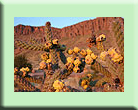White Sands National Monument – Tours of New Mexico
Discover giant white gypsum dunes and the unique ecosystem that exists here.
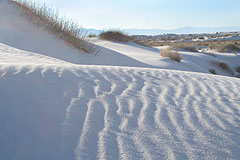 The Tularosa Basin, visited on our tours of New Mexico, contains the worlds largest gypsum dune field. With dunes as high as 50 to 60 feet and approximately 4.5 billion tons of white gypsum sand this giant area provides a unique habitat for animals and plants as well as a fascinating geological environment. The dune field is estimated to be between 6-10,000 years old and the ancient lake bed of Lake Otero has occupied the basin for some 20,000 years. Today this area receives small amounts of seasonal rain, resulting in seasonal Lake Lucero. For much of the year this area is very dry and windy making for a unique habitat that only the hardiest plants and most adaptable animals can survive. While you visit on our tour of New Mexico you will be introduced to the unique ecology, geology and cultural history of the region.
The Tularosa Basin, visited on our tours of New Mexico, contains the worlds largest gypsum dune field. With dunes as high as 50 to 60 feet and approximately 4.5 billion tons of white gypsum sand this giant area provides a unique habitat for animals and plants as well as a fascinating geological environment. The dune field is estimated to be between 6-10,000 years old and the ancient lake bed of Lake Otero has occupied the basin for some 20,000 years. Today this area receives small amounts of seasonal rain, resulting in seasonal Lake Lucero. For much of the year this area is very dry and windy making for a unique habitat that only the hardiest plants and most adaptable animals can survive. While you visit on our tour of New Mexico you will be introduced to the unique ecology, geology and cultural history of the region.
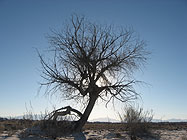 Despite the harsh conditions of the dune landscape a multitude of animals and plants thrive here. Interesting evolutionary traits can be observed – for example, many of the animals here are white, or at least much lighter in color than they are elsewhere. This includes everything from insects to mammals. This camouflage helps animals escape the eyes of their natural predators. When you walk around the dunes, particularly in the evening, keep a sharp look out for these creatures. There are many other adaptations that these animals have developed, for example the bleached earless lizards and cowles prairie lizards can change color depending on the temperature, allowing them to absorb more or less heat. Most desert animals are nocturnal, burrowing underground during the day and only coming out at night when the white sand has cooled.
Despite the harsh conditions of the dune landscape a multitude of animals and plants thrive here. Interesting evolutionary traits can be observed – for example, many of the animals here are white, or at least much lighter in color than they are elsewhere. This includes everything from insects to mammals. This camouflage helps animals escape the eyes of their natural predators. When you walk around the dunes, particularly in the evening, keep a sharp look out for these creatures. There are many other adaptations that these animals have developed, for example the bleached earless lizards and cowles prairie lizards can change color depending on the temperature, allowing them to absorb more or less heat. Most desert animals are nocturnal, burrowing underground during the day and only coming out at night when the white sand has cooled.
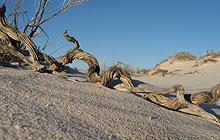 As you go on our guided nature tours of New Mexico look for tracks in the sand to alert you to desert wildlife in White Sands National Monument. Because animals are often difficult to spot you can keep an eye out for the remains that they leave. For example the yucca pod pictured bellow to the right has a variety of animal tracks around it. These were probably left by a rodent, possibly the desert kangaroo rat. These animals are well adapted to life in the desert, eating only dry seeds and creating water metabolically while digesting food. Other animals require leaves for their water supply, as you look around you on the dunes you will realize that many plants only have tiny and tough leaves, making this a challenging affair. Despite all the challenges of desert life there are about forty-four species of mammals, twenty-six of reptiles and many amphibians and insects.
As you go on our guided nature tours of New Mexico look for tracks in the sand to alert you to desert wildlife in White Sands National Monument. Because animals are often difficult to spot you can keep an eye out for the remains that they leave. For example the yucca pod pictured bellow to the right has a variety of animal tracks around it. These were probably left by a rodent, possibly the desert kangaroo rat. These animals are well adapted to life in the desert, eating only dry seeds and creating water metabolically while digesting food. Other animals require leaves for their water supply, as you look around you on the dunes you will realize that many plants only have tiny and tough leaves, making this a challenging affair. Despite all the challenges of desert life there are about forty-four species of mammals, twenty-six of reptiles and many amphibians and insects.
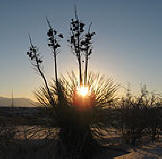
Yucca plants have created amazing adaptations to survive in the harsh sand dune environment of White Sands National Monument. As sands shift and move most ordinary plants are buried- but not the soaptree yucca. In a process called “stem elongation” the yucca plant rapidly grows taller, as much as 12″ a year, keeping its flowers and leaves above the sand. This plant can grow to be 30′ tall, though by looking at it you could never tell since the majority of the stem is buried in the sand. The yucca roots have been used, by Native Americans, as a substitute for soap and the leaf fibers were used for basket weaving. You will see many of these yucca plants as you travel with us on our tours of New Mexico and Arizona.
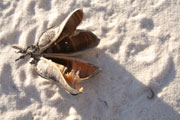
Small Group Bus Tours of New Mexico and Arizona – Read about these attractions, close to the White Sands National Monument that you will also visit on our small group tour.
If you have any questions about our Arizona and New Mexico Adventure Tours please feel free to contact us at info@traveldreamwest.com. Our Southwest Adventure tour is scheduled for at least once a year, and can be booked for a group as a custom adventure travel tour at other times.



